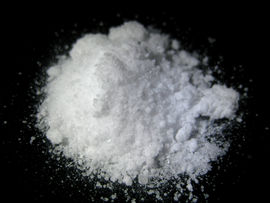Ammonium carbonate

| |
| Names | |
|---|---|
| IUPAC name
Ammonium carbonate
| |
| Other names
Ammonia sesquicarbonate
Baker's ammonia Diammonium carbonate E503 Sal volatile Salt of hartshorn | |
| Identifiers | |
| Jmol-3D images | Image |
| |
| Properties | |
| (NH4)2CO3 | |
| Molar mass | 96.09 g/mol |
| Appearance | White solid |
| Odor | Strong ammonia |
| Density | 1.50 g/cm3 |
| Melting point | 58 °C (136 °F; 331 K) (decomposes) |
| Boiling point | Decomposes |
| 55.8 g/ml (0 °C) 100 g/ml (20 °C) Decomposes (58 °C) | |
| Solubility | Insoluble in benzene, hexane |
| Hazards | |
| Safety data sheet | ScienceCompany |
| Flash point | Non-flammable |
| Related compounds | |
| Related compounds
|
Ammonium bicarbonate |
| Except where otherwise noted, data are given for materials in their standard state (at 25 °C [77 °F], 100 kPa). | |
| Infobox references | |
Ammonium carbonate is a compound with the chemical formula (NH4)2CO3.
Contents
Properties
Chemical
Ammonium carbonate decomposes when heated above 58 °C to ammonia, carbon dioxide and water vapor:
- (NH4)2CO3 → 2 NH3 + H2O + CO3
Reaction with acids gives ammonium salt of said acid and releases carbon dioxide:
- (NH4)2CO3 + 2 HNO3 → 2 NH4NO3 + H2O + CO2
Physical
Ammonium carbonate is a white solid, with a strong odor of ammonia, soluble in water. It decomposes in hot water (>58 °C) releasing ammonia and carbon dioxide. It has a density of 1.50 g/cm3.
Availability
Ammonium carbonate is available as baker's ammonia in some food stores, though most will sell only ammonium bicarbonate.
It can also be purchased online. ScienceCompany will sell a 8 oz. (227 g) bottle at 9.95 $.
Preparation
Ammonium carbonate can be prepared by bubbling ammonia through an aqueous solution of ammonium bicarbonate.
- NH4HCO3 + NH3 → (NH4)2CO3
Projects
- Make ammonium salts
- Make ammonium carbamate
- Make ammonium bicarbonate
Handling
Safety
Ammonium carbonate gives off ammonia fumes, which are irritating and toxic if they build up in a closed environment. During hot summers, the decomposition is rapid.
Storage
Ammonium carbonate is best stored in closed containers and kept in cold places. To limit the ammonia gas released, you can store the carbonate in a resealable bag, which in turn can be placed in a container. Do not seal it completely, as ammonia pressure will slowly build up inside the bottle, and you will need to release it periodically.
Disposal
Ammonium bicarbonate can be neutralized with an acid and poured down the drain, or just poured down the drain, as it poses no danger to the environment.
Can also be simply poured in the ground, as it's a good (albeit less effective) nitrogen source for plants.
References
Relevant Sciencemadness threads
- Chemical pages without CAS Registry Number
- Articles without EBI source
- Chemical pages without ChemSpiderID
- Chemical pages without DrugBank identifier
- Articles without KEGG source
- Articles without InChI source
- Articles without UNII source
- Articles containing unverified chemical infoboxes
- Chemical compounds
- Inorganic compounds
- Ammonium compounds
- Carbonates
- Materials unstable in basic solution
- Materials unstable in acidic solution
- Unstable materials
- Readily available chemicals
- Materials available as food grade